
I first witnessed the power of email marketing as one-half of a two-person marketing team for an indie bookstore, crafting email newsletters that promoted new titles, announced upcoming author signings, and spotlighted staff recommendations.
It never failed to amaze me how impactful those simple newsletters were for influencing customers, impacting sales, and boosting event turnout. They can work for your business-to-business (B2B) operations, too.
Consider this article your comprehensive guide to B2B email marketing campaigns. We’ll start with a quick refresher on the basics of email marketing campaigns. Then, we’ll take an in-depth look at the many different types of campaigns — with email marketing examples!
After, we’ll sweeten the pot by sharing tips and email marketing templates that make crafting effective email marketing messages nearly as easy as hitting “send.”
When you’re finished reading, you’ll be ready to plan and launch an incredible email marketing campaign that keeps your business at the top of your customers’ inboxes — and at the forefront of their minds.
What is an email marketing campaign?
Email marketing campaigns deliver coordinated marketing messages to consumer inboxes. They’re essential components of a business’s overall marketing strategy, proven to increase consumer engagement, generate clicks and conversions, and increase sales.
Regardless of your particular B2B goals, there’s an email marketing campaign designed to help you achieve them.
Email marketing examples that work
Email marketing can be simple if you’re working with the best tools. Partnering with an email marketing services provider like Constant Contact is a simple solution for eliminating guesswork and tapping into the strategies aligned with your goals.
And it never hurts to familiarize yourself with the various types of B2B email marketing campaigns, why they work, and how.
E-commerce email marketing campaigns
E-commerce email marketing campaigns help online retailers connect with customers individually, even if you never see them face-to-face. E-commerce email marketing includes cross-selling/up-selling messages, product announcements, and transactional campaigns.
You can increase website traffic, boost conversions, and drive sales by delivering personalized, relevant marketing messages directly to consumers’ inboxes.
Abandoned cart campaigns
Abandoned cart emails are marketing messages sent to customers when they browse your online store, add items to their shopping cart, and then neglect the crucial last step of finalizing their purchase.
According to the Baymard Institute, consumers abandon digital shopping carts 70.19% of the time, on average. Abandoned cart emails effectively re-engage shoppers and increase online retail sales through incentives, compelling headlines, and personalized messages.
Here’s an example of an excellent abandoned cart email:
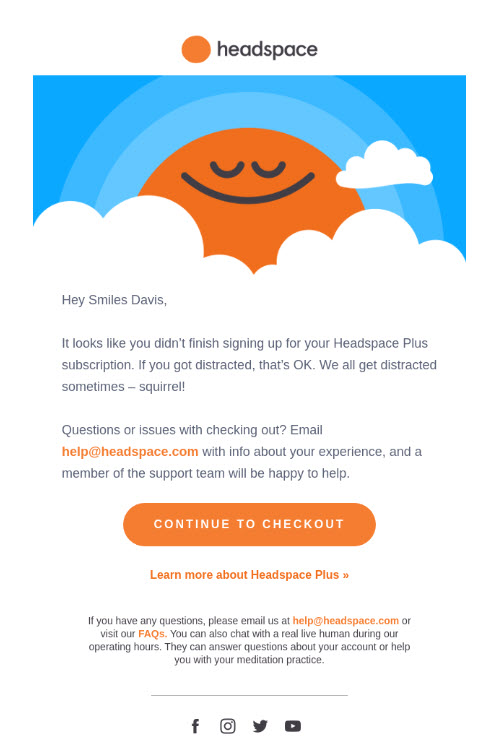
Engagement and awareness
Engagement and awareness campaigns marshal the power of email marketing to increase customer engagement and build brand awareness. They put your brand name and image in front of customers, building familiarity and trust and raising your profile. They can also help familiarize consumers with your product(s) or service(s).
Engagement and awareness email marketing examples include:
- Traffic generation campaigns
- Awareness campaigns
- Content round-up campaigns
- Pre-launch/teaser campaigns
- Referral campaigns
- Milestone campaigns
- Win-back campaigns
Let’s take a closer look at some effective engagement and awareness campaigns.
Social media engagement campaigns
Boosting customer engagement with your social media accounts doesn’t happen solely via social media. By integrating email marketing with social media, you can direct your audience’s attention to the content you post on Facebook, Instagram, LinkedIn, and the other platforms your business uses.
You should include overt calls-to-action (CTAs) encouraging subscribers to follow you on other platforms or include clickable icons that redirect to your social media pages.
Here’s an example of Starbucks including social media links at the bottom of a marketing email:
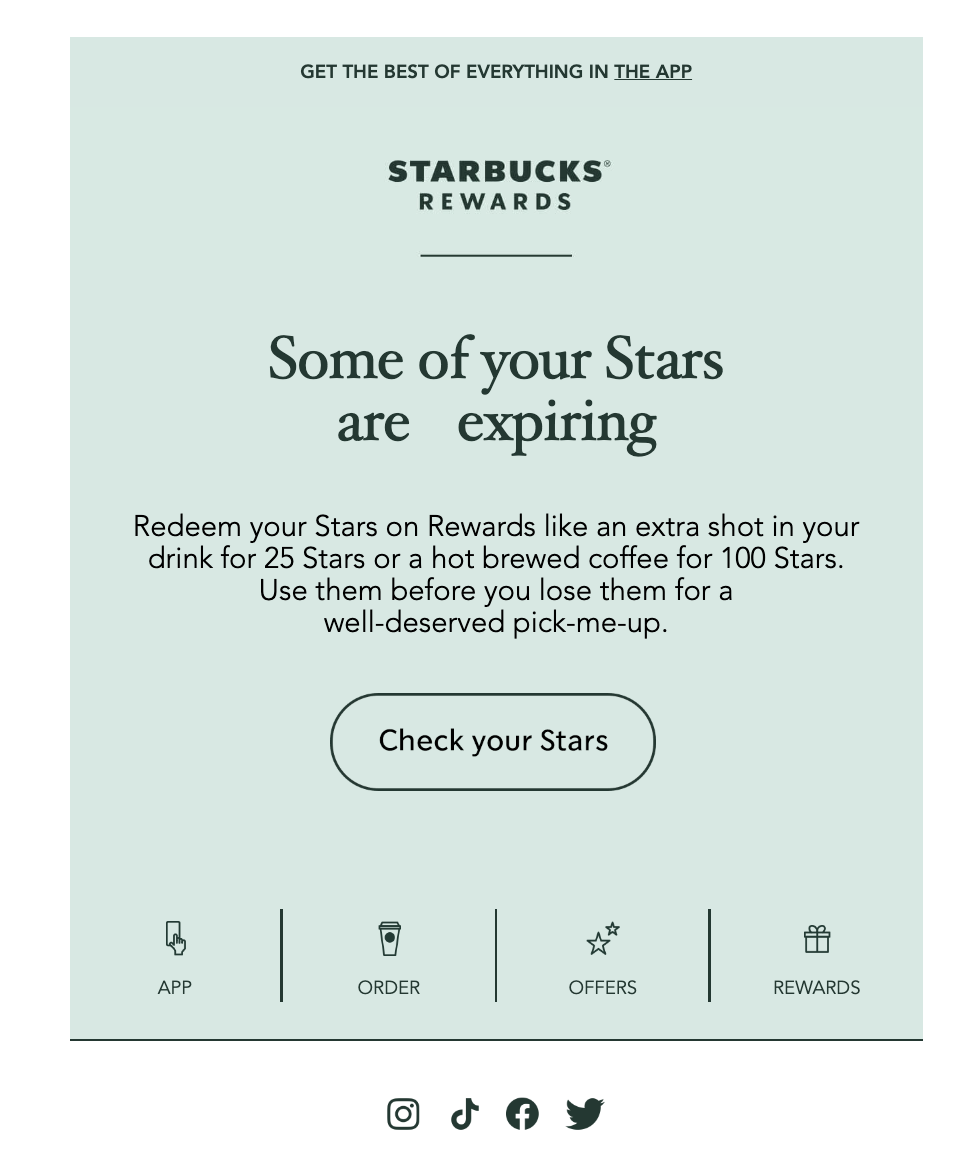
Blog posts
Do you create informative blog posts for your website? Then, share them with your B2B audience via your newsletter.
Make sure you space out how often you send such emails. And, of course, it’s vital that those blog posts are helpful and address pain points your audience needs to solve.
Jimmy Daly of Superpath sends his readers a weekly roundup of useful blog content. Here, there’s a roundup of different types of posts that include podcasts, interviews, trends, and upcoming workshops.
This kind of variety featuring clear and focused value will win over your audience. So, share blog content and curate valuable posts that will help your B2B audience grow.
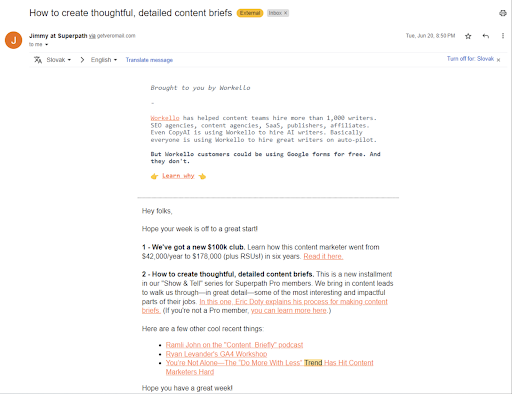
Industry updates and trends
Sharing industry news, updates, and trends is another vital type of B2B email marketing content.
In this case, you’re not delivering a body of research to your audience. Instead, you’re curating useful snippets of information from various sources and delivering them to your readers’ inboxes. This allows them to stay up-to-date on your industry’s latest news and trends.
Readers will appreciate this because finding useful B2B information through general online searches can be challenging. Content about technological changes, legal developments, economic trends, and the like is often available behind gated content in B2B groups. And sometimes, only a handful of experts and professionals in the field know about them.
Building a newsletter that helps business professionals stay abreast of such changes will help you create a loyal and engaged readership.
Check out this example from MonsterInsights that shares the latest news about using Google Analytics to help manage website data.
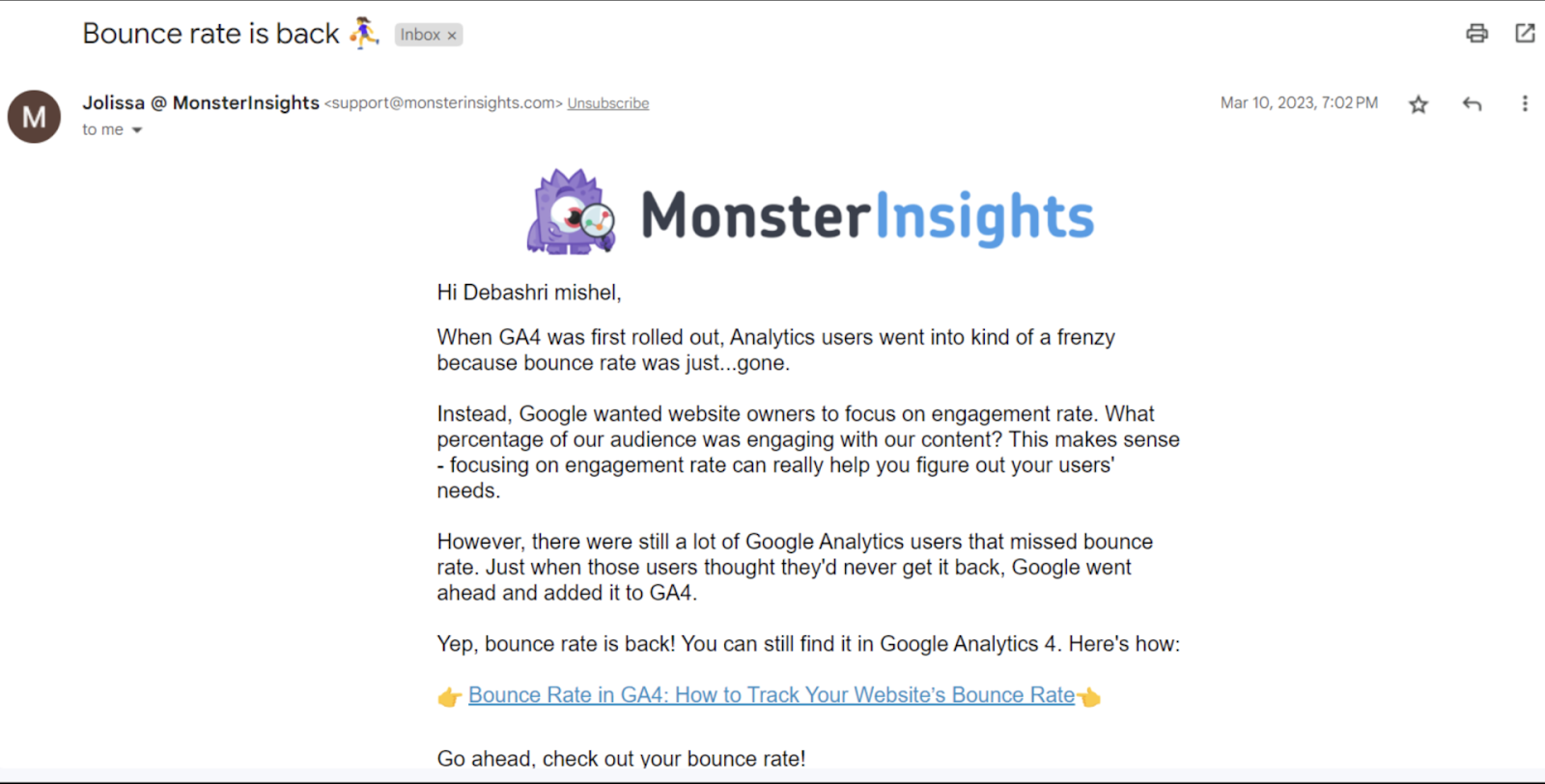
Lead generation and nurturing
Lead generation and nurturing are critically important processes for building a solid customer base. Lead generation refers to finding potential customers who are likely to convert, while lead nurturing refers to the steps your business can take to turn converted leads into repeat customers.
Lead generation and nurturing email marketing examples include:
- Drip campaigns
- Educational/how-to campaigns
- Segmented campaigns
- Surveys/feedback requests
- Customer onboarding
This lead nurturing from 8AM Creative email gives subscribers access to exclusive content to promote loyalty to their brand.
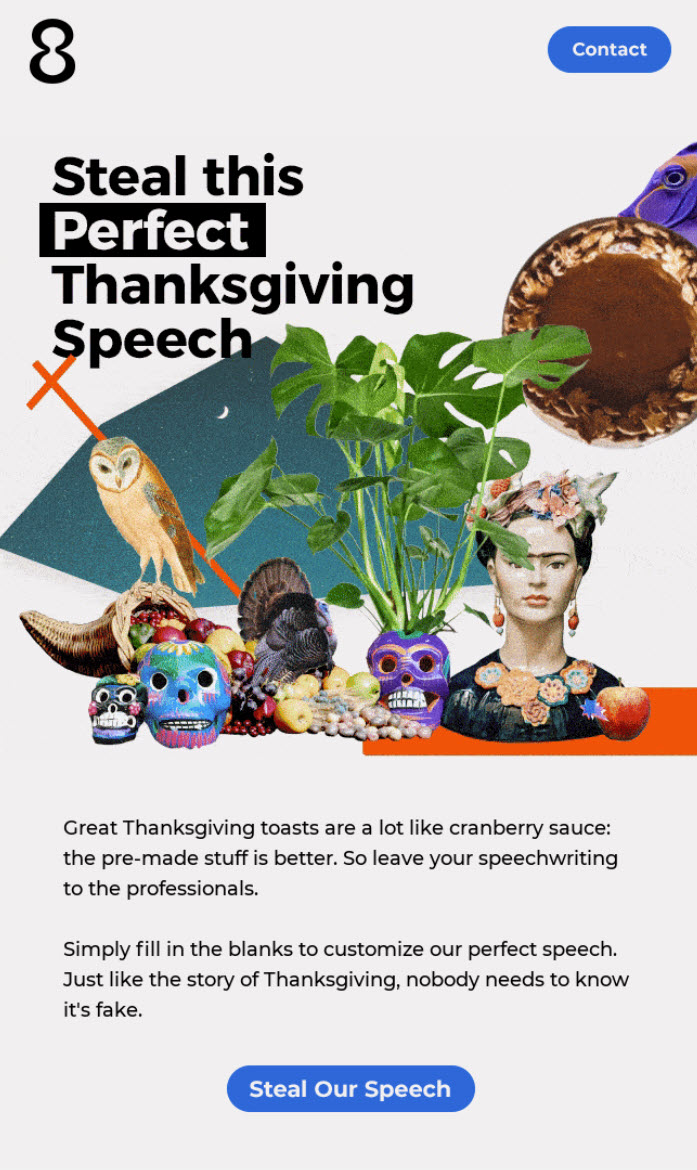
Brand updates and news
WeWork is a great example of how to use news and updates to engage your B2B clients effectively. They highlight the value of investing in their space and offer compelling reasons to engage with the brand. They also spotlight company culture by going beyond just offering office space to their clients.
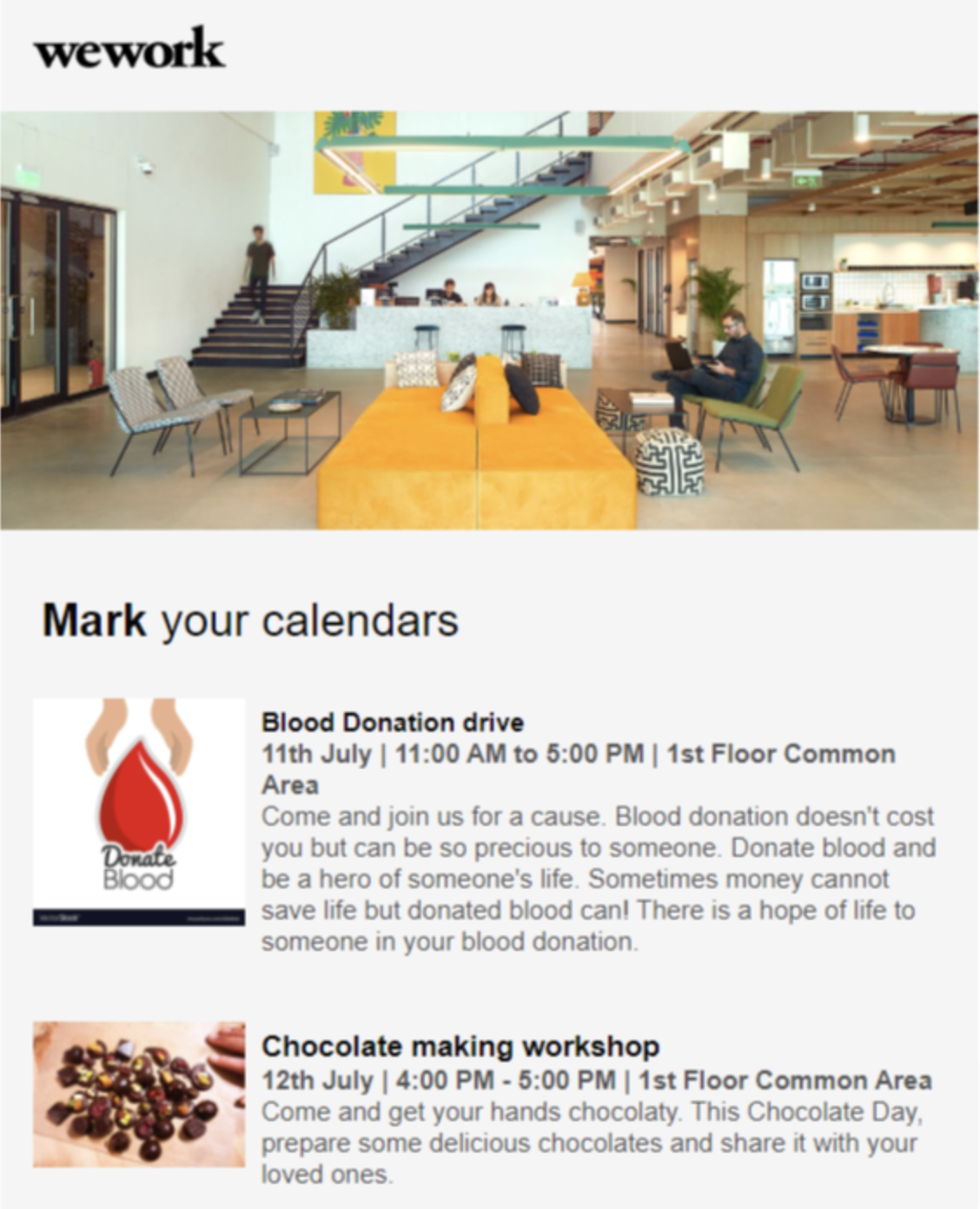
Case studies and success stories
Sharing powerful success stories and case studies doesn’t just build social proof. It also gives your B2B audience a clear idea of what working with your brand can look like. It can also illuminate how to use your products and services to create better results.
Case studies and success stories include data points, real-life problems, and the actual solutions your business created. They can enliven seemingly dull business problems and offer practical and actionable steps.
So, make sure to build case studies based on your customers’ experiences. And share the stories of what you and your B2B customers learn with your email list.
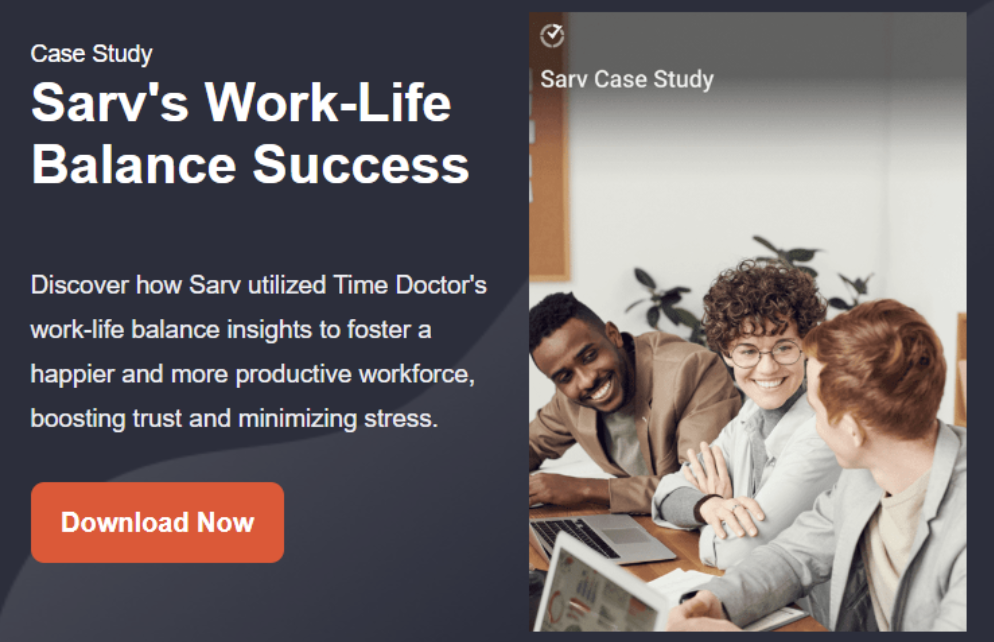
In the Time Doctor email marketing example above, adding a ‘Download Now’ button and linking it to a landing page helps the brand create engagement and enables the collection of data to gauge how effective this email campaign is.
In this way, you can also use case studies to provide your audience with useful and engaging content.
Revenue generation campaigns
Effective email marketing increases customer engagement and improves customer retention. That means a larger community of brand loyalists who shop more regularly, spend more per purchase, and recommend you to others. In other words: revenue growth.
Plus, email marketing is a cost-effective promotional tool that boosts traffic in person and online, making it especially handy for small businesses looking for budget-friendly ways to increase revenue.
Loyalty programs, urgency/scarcity messaging, and promotional emails are other examples of revenue-generation email marketing campaigns.
Customer relationship and communication
Managing customer relationships and reaching out regularly to promote a product or get customer feedback improves retention, especially for small businesses. Email marketing provides a direct line of communication, which is key to strengthening customer bonds.
Customer relationship and communication email marketing examples include:
- Welcome emails
- Newsletters
- Birthday emails
- Anniversary emails
- Customer delight
- Subscriber preferences
- Employee emails/recruitment emails
New product features
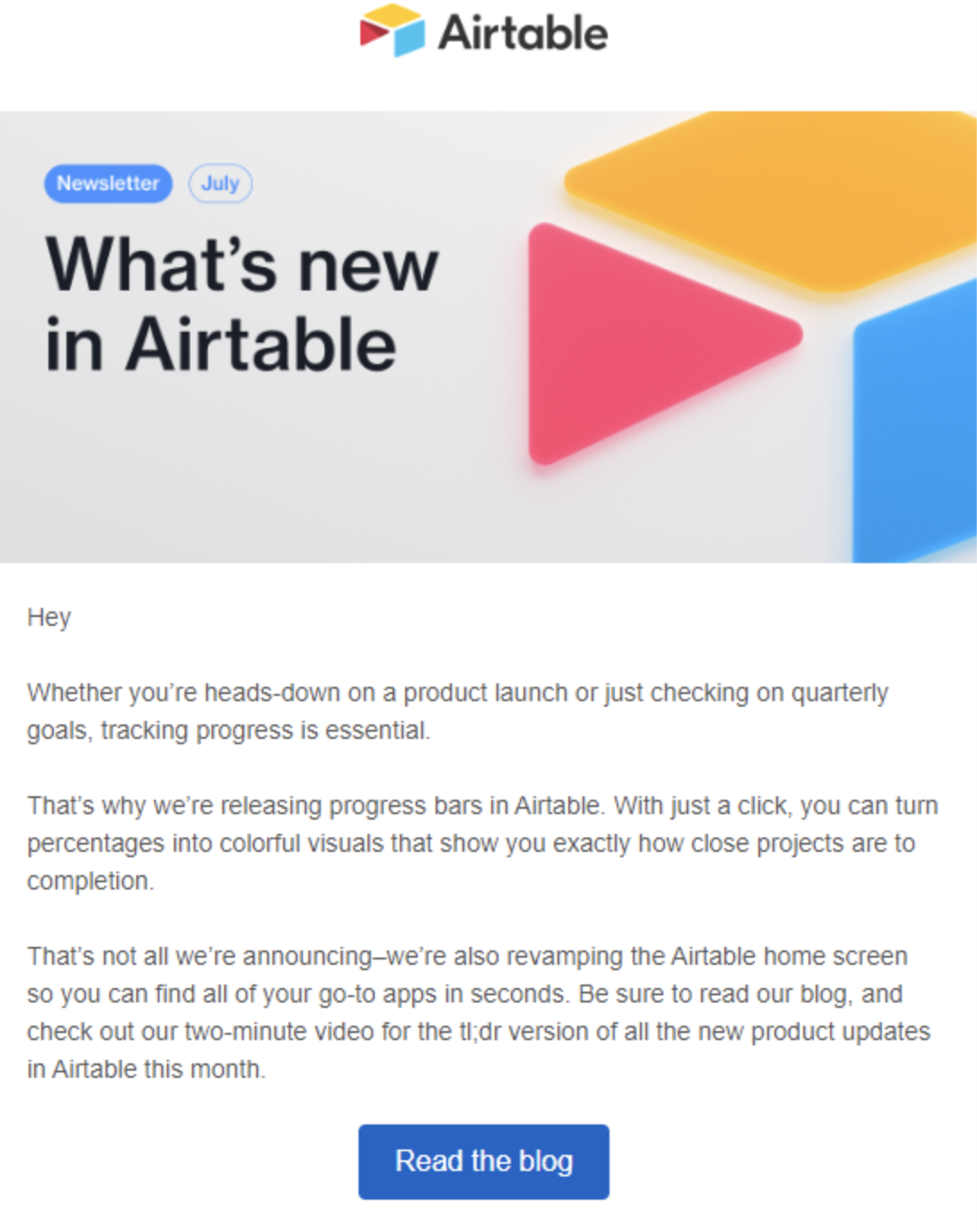
Airtable recently sent out a newsletter about their new product features. This included the addition of a progress bar and a new home page that makes navigating through content much easier.
This is an effective way to keep people informed and engaged with the product.
Informing your B2B audience about new product features is a great way to show that the product keeps getting better, and that you’re still keeping up with industry trends.
Event promotion campaigns
Hosting virtual and in-person events is a great way to engage customers, boost your brand’s image, and promote the products or services you provide. Whether you’re hosting a product launch party, product demonstration, or business expo, it’s essential to implement a few event marketing strategies to guarantee a good turnout.
Event invitations
Education is a vital aspect of B2B relationships. This is because B2B products and services are often more complex and require educational material, good customer support, and plenty of live virtual events to help customers make the best use of your offerings.
One important example of B2B event marketing is sending invitations for virtual opportunities like workshops and webinars.
Hosting one-hour workshops, Q&A sessions, and similar virtual experiences is a fantastic way to engage customers and help them address common pain points.
It’s essential to send timely emails with information about virtual events so that customers can plan to attend. You should also include a link to a landing page with event registration features to collect leads and send the virtual event information to participants.
Check out the following example by Slack, a messaging communication platform widely used by many businesses.
In this example, Slack promises clients they will learn how to improve employee productivity. They also sweeten the deal by offering a free coffee to the first 100 participants.
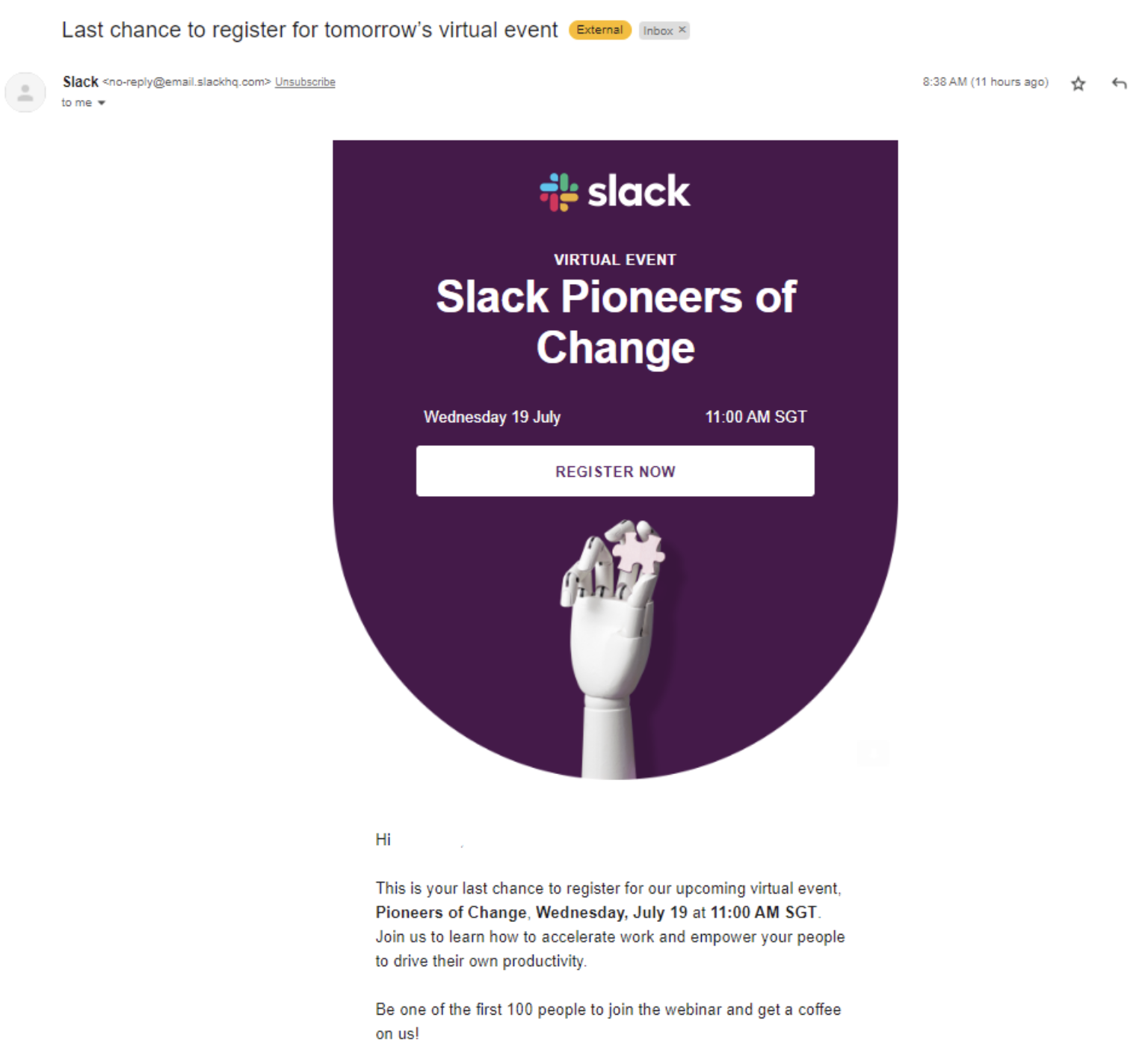
Nonprofit and cause-related
Nonprofit email marketing campaigns are a wonderful opportunity to marshal the power of nonprofit storytelling to raise awareness, educate subscribers about the nonprofit organization’s goals, and raise funds.
For example, your nonprofit can use drip email campaigns to provide updates on a fundraiser’s progress and solicit both initial and repeat donations. Plus, automated email marketing means you never have to worry about sending thank you emails to contributors.
Tips to make your B2B email marketing effective
However you choose to engage your B2B email list, you want to keep the following tips in mind.
- Use a customer relationship management (CRM) platform to manage your audience’s experiences and journey with your company. A good CRM platform will help you keep track of relevant customer information to improve your offerings.
- Personalize your email content by addressing your user with their first name in the subject line or in the body. Using a person’s name attracts their attention and makes them feel that the content is relevant to them.
- Avoid sending emails too often. Scarcity often leads to the perception of higher value of the scarce object; you don’t want to send emails too frequently, as this will dilute the value of your outreach. Send emails regularly but ensure that they offer value and are well-spaced out.
- Focus on how you can benefit your audience. B2B professionals and decision-makers often have to justify their investment in a product. Always link your offerings to specific benefits and outcomes. And showcase proof of the same with case studies and research.
- Use emails to lead your audience down the buyer’s journey path — i.e., deliberately plan the sequence of your emails to move your audience from gathering information to taking action by investing in your products/services.
By following these tips, you stand to make your email marketing more powerful, leading to improved engagement and sales.
Turn your B2B email marketing campaigns into revenue-generating engines
As a B2B marketer or business owner, you can’t afford to miss out on the benefits of email marketing.
The email marketing examples in this blog will help you craft engaging emails and give your audience what they want. Use them as references in your own email marketing campaigns.
And be sure to check your analytics and email marketing reports to find areas for improvement. With time and practice, you’ll turn your B2B email marketing campaigns into revenue-generating engines.




